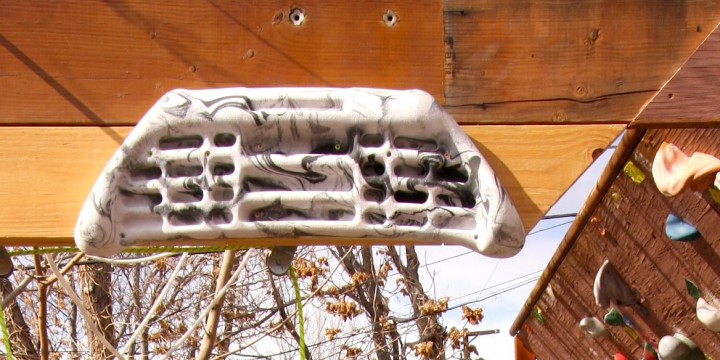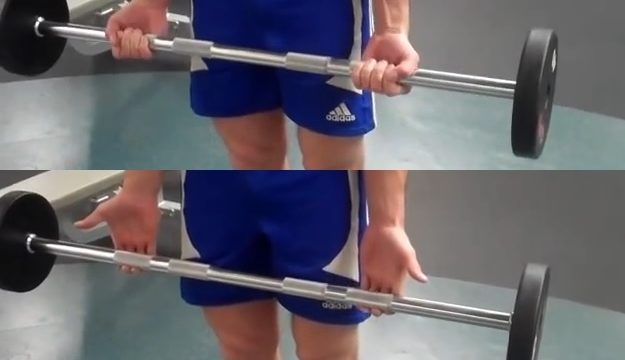Background
Heard about finger rolls from several different sources. One, Two, Three. I said I’d try them out because I like to see if certain things work for me or not like my iontophoresis and antihydral experiments for dry fingers.
Here’s a video about how they are done.
The blurb on Eric Horst’s site suggests they’re actually a very old exercise that has just been lost to the climbing community over time.
Todd Skinner turned me on to this exercise back in 1990, and I’ve since become a believer. Muscular gains from this exercise are reasonably quick and obvious, and they seem to translate fairly well to climbing despite the obvious lack of specificity to climbing.
Todd credits these finger rolls for some of his most significant gains in finger strength, since he first picked up on this exercise from Eastern Bloc climbers he meet on the World Cup circuit in 1987.
The Soviet climbers claimed that heavy finger rolls produce measurable gains in forearm circumference (a sign of muscle hypertrophy), whereas strength gains from fingerboard or campus training are primarily the result of neurological adaptations. This statement seems reasonable since the heavy finger rolls cause repeated, high-intensity eccentric and concentric contractions of the forearm muscles. Also, pairing up heavy finger rolls with plyometric training (e.g. campus training) could produce the synergistic gains that have been shown to result from the Complex Training protocol I advocate for advanced climbers (more on this in a future article!).
[…]
As far as weight is concerned, it must be HEAVY! Maximum strength training demands the use of an appropriately heavy weight that only allows you three to six very intense repetitions. Therefore, while finger rolls with a “light” weight (e.g. 30- or 40-pound dumbbells) may pump you up, they are ineffective for developing maximum finger strength. After a warm-up set with the bar weighted to about 50 percent of your body weight, the goal is six heavy sets with a good rest of three to five minutes between sets. A weight about equal to your bodyweight is a good first guess for a “working weight.” Add more weight if you can do more than six reps, or removed if you can’t do six sets of at least three repetitions. With practice, you should be able to build to 125 to 150 percent of body weight…AND build forearms of steel!
Also, a mountain project post on them.
Note: I mainly boulder and don’t lead or trad. So I’m mainly using these to improve my bouldering ability and overall hand strength.
My thoughts before starting
Eric Horst’s article with them suggested that these helped with increases in hypertrophy.
- Strength = neurological adaptations * muscle cross sectional area (hypertrophy)
Hypertrophy is predicated on:
- Maximal tension
- Muscle damage
- Metabolic stress
My thoughts before starting were that since the strength equation is basically neurological adaptations * muscle cross sectional area, finger rolls would be good at improving hypertrophy which would also directly increase strength. Not sure how much it would help, but I was expecting some improvement. Most high level climbers also have massive forearm hypertrophy, so I figured I might as well start now and hopefully get bigger forearms to help me in the long run.
I was overall unsure about how much my max strength would improve overall since I would be getting substantially less practice with half crimp specific movements. Finger rolls aren’t necessarily “specific” to the joint angles that you hang with half crimp. Thus, I decided to keep at least 1 set of max hangs during this time to see if my max hangs would improve at all during this experiment.
What I did
I’ve been having a bit of nagging issue with my middle finger PIP joints, and higher rep work is good for connective tissue and joints. Thus, I decided to “modify” the program a bit instead of going super heavy in the 5 RM range to boost it up to at minimum in the 20 rep range.
Since I did NOT want to do both max hangs on hangboard and finger rolls and develop greater overuse injuries, what I did was:
- Reduce my volume for single arm max hangs to 1 or 2 sets for half crimp full pad or about 25mm.
- Reduce my volume for single arm max hangs to 1 or 2 sets for half crimp ~14mm — I would have preferred 10mm but I’m working with a crappy hangboard (see below) at the gym. Unfortunate, I know. 1 or 2 sets depending on how I feel.
- I also removed open hand (3 finger drag) from my program since finger rolls would seem to double as open hand work basically.
- I don’t train pinch because it didn’t really help me the few times I’ve tried.

Hanger 18 gyms are pretty meh as far as workout equipment goes.
Results
Initial test:
- 4-5×20 at 135 lbs with ~3-4 minutes rest between sets
The first few sessions I ended up aiming to improve my reps with just the 135 lbs. Got to 25 reps, then 30. Then I started boosting up the weight. After that a couple of workouts alternated between working 20 and 40 reps. I ended up favoring a more endurance protocol since I was running short of time on some workout days, and I’ve been working a longer V10 project outside, which I punted the last V1-2 move at the end. So finger endurance was a more obvious route to go in conjunction with what I was working on outside.
Final results (over 4 week period):
- 1×20 at 225 lbs. The last couple workouts I went for a ~20 max rep set and end up being able to do 225.
- 5-6×20 at 185 lbs with 60-90s rest between sets.
- Also tried a few “burnout” sets and was able to do 1×50 at 135 lbs about 3 weeks in. Huge rep gains here.
Overall, solid improvement going from around a RM of 135 lbs or about 90-100% of my bodyweight to 225 lbs or about 150% of my bodyweight as I run about 140-145 lbs.
How did it translated to actual climbing?
- PIP joint soreness actually improved while on this protocol, even moving up weight. I did somewhat expect this, but it was good to confirm that this helped my injury.
- Forearm hypertrophy increased substantially (see above picture). Unfortunately, I did not think to take before/after pictures or measurements, but here is approximately how much my forearms hypertrophied over the course of the couple weeks. Yellow line is about where it started, and you can see where it is now. Much more noticeable definition with both flexors and extensors.
- The 1-2 sets of max hangs increased 15 lbs over the 4 weeks. I had been plateaued for a while.
* My pinch grip noticeably improved on the wall. I think it might be because of the co-contraction of extensors during heavy flexor loading - Not really “scientific” but the V10 project I mentioned above (over 3 sessions) started at “desperate” during the crux and moved to “reasonable” over the course of the workouts and would’ve went except for the punt.
- Improved endurance and contact strength (which is also to be expected with improved max hangs and endurance reps).
Overall, I’m a believer. This is the best “one thing” I’ve found aside from actually climbing that seems to have increased my overall abilities fairly rapidly, at least with the 20+ rep protocol. I’m all about finding what works best for me personally.
Bear in mind that I also do not do sport only bouldering, so some of the “gains” from the higher reps may also fall under newbie gains for me. I would suspect that climbers who do both sport and bouldering may experience less results than I did since their forearms may already be somewhat adapted to being pumped at high repetitions. However, they should still experience at least some hypertrophy and some hand strength gain.
This also seems like a solid “alternative” for maintaining finger strength if you’re on vacation and can’t really go to a gym. It would help substantially in staving off the loss of finger strength by continually working the FDS and FDP muscles. That’s been one of my biggest issues with climbing as almost every year I’ve been climbing I’ve had 2-3 week breaks here and there from traveling, vacations, and whatnot which have stalled my progress for longer periods of times.
I would be interested to see how the 5-10 RM protocol would work, but my finger needs to heal up to full before I would try that. For now, I’m sticking between 20-50 reps and the current system I’ve set up. I’ll probably post another update another month or two in. I highly doubt that my very good gains would continue on this trajectory, but there should still be some solid gains.
Anyway, I suggest adding these to your program for a month to give a try. You can try the 5 RM protocol, or my 20 RM protocol. I think you’ll make good gains.
~2 Month update:
I’ve talked with about 5 more climbers I’ve convinced to try finger rolls as well. They report at the very least increased contact strength and/or fingers are feeling better than ever. Not sure if most people have had as good of results as I did, but there was at least some benefit to keep them in the program.
I tried some “heavier volume” type stuff with up to 10-15 total sets, but my climbing and grip strength started to suffer. I think the sweet spot with climbing + minimal hangboard + finger rolls for me seems to be in the 4-8 range for sets of finger rolls.
I’m about to try another month with slightly more volume for hangboard and sticking with 3 sets of finger rolls: 3 sets of 20 RM and 3 sets of ~40-50 RM. Currently, I’ve made it up to 225 lbs for 25 strict repetitions, and 185 lbs for about 45 strict repetitions.
Hangboard slightly improved during this time, but plateaued with the extra volume. I’m going to test to see if hangboard improves more with the lower volume now, which it should.
Author: Steven Low
Steven Low is the author of Overcoming Gravity: A Systematic Approach to Gymnastics and Bodyweight Strength (Second Edition), Overcoming Poor Posture, Overcoming Tendonitis, and Overcoming Gravity Advanced Programming. He is a former gymnast who has performed with and coached the exhibitional gymnastics troupe, Gymkana. Steven has a Bachelor of Science in Biochemistry from the University of Maryland College Park, and his Doctorate of Physical Therapy from the University of Maryland Baltimore. Steven is a Senior trainer for Dragon Door’s Progressive Calisthenics Certification (PCC). He has also spent thousands of hours independently researching the scientific foundations of health, fitness and nutrition and is able to provide many insights into practical care for injuries. His training is varied and intense with a focus on gymnastics, parkour, rock climbing, and sprinting. Digital copies of the books are available in the store.
